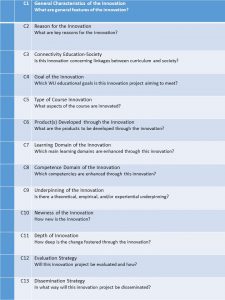Blog by 4TU.CEE chairman Perry den Brok (WUR)
At each of the 4 Technical Universities in the Netherlands, education is rapidly changing as a result of growing and more diverse student numbers, increasing opportunities for using ICT in educational processes, preparing a wider range of students for a wider range of engineering profiles, and changing curricula, offering more flexibility and personal choice. At each of the four institutes, grants or other support is offered to teachers who want to innovate their courses or programmes.
An interesting question is whether these grants and other support initiatives result in innovation of education, and if so, with respect to what topics, under what conditions and with what results. In the past, 4TU.CEE already engaged in a study interviewing innovators about various aspects of their innovation projects. It gave an overview of the type of topics and types of projects innovators were engaged in. This first initiative resulted in an interesting overview of reasons for innovating, topics of innovation, and potential success or fail factors. It also led to the creation of the 4TU.CEE innovation map, a database of educational innovations of the 4 TU’s.
Framework
During the past year, Wageningen University and Research (WUR), via the 4TU.CEE started a study to more scientifically underpin its innovation process for innovating courses. As a result, a framework was constructed based on the literature, consisting of relevant criteria that institutes and innovators might want to consider before starting an innovation (see Table 1).
Table 1 – The 13 Criteria (C) constituting the Evaluation Framework

A team of researchers consisting of Valentina Tassone (project leader), Perry den Brok, Harm Biemans and Piety Runhaar from the Education and Learning Sciences group analysed well over 85 Wageningen course innovation proposals of the past three years using the above framework. The complete report of this analysis can be found here.
Currently, based on the findings, the team is analysing a hand full of cases more in detail, not only looking at the innovation proposals, but also looking at the actual implementation and evaluation of the innovations.

Recommendations
The study has resulted in a series of recommendations, that are also of interest to the wider audience of teachers and educational innovators, both within and outside the 4TU.CEE institutes. These recommendations are:
*Strive for inclusive and evenly spread educational innovations at an institute
This can be realised, for example, by incentivizing more complex collaborative efforts across faculties, science groups and/or chair groups; by offering educational support for improving proposals that would otherwise not be granted, and that are related to groups less active in getting educational innovation grants; by incentivizing academics in tenure tracks to engage in educational innovation endeavours (by receiving credits for I t when their proposal is granted); by consulting students and integrating students’ voice and needs when shaping the educational innovation agenda and related calls.
*Create a balance between pre-set content requirements and an open content format, when structuring future calls for innovation
Inevitably, educators will tend to direct the content of their innovation plans and write their proposals in a way that fulfils pre-set requirements, in order to get the grant. Fulfilling the formal educational goals as pre-set requirement can boost achievement of those goals. On the other hand, it can potentially hamper the creation of other new possible educational goals that innovators might truly want to pursue. Make sure that calls provide enough openness for shaping the content of the proposal, and that educators are offered enough freedom to express their creative ideas and their students’ specific ambitions.
*Let educational innovation be theory-based and evidence-informed
Let a more pragmatic problem-orientation be coupled with an educational science-orientation through which scientific concepts and evidence can inform the development of the specific innovation. This can take place, for example, by requesting a sound theoretical and/or empirical underpinning of education innovation proposals; by using empirical findings, as the ones emerging from this study, for inspiring the development of educational policy and innovation calls; etc.
*Consider distinguishing and alternating between an “implementation of good practices” fund and an “experimentation” fund
An “implementation of good practices” fund can focus on supporting the implementation of already known successful tools and approaches, and thus on enabling the upscaling of good practices. On the other hand, an “experimentation” fund can focus on supporting the creation of new tools and new forms of education and thus on enabling experimentation of not yet known practices, to be undertaken in a transparent way allowing also for possible failures from which to learn. Making this distinction, and possibly alternating, between those two innovation funds can help acknowledging the relevance of, or even boosting, both forms of innovation.
*Be conscious that the most innovative proposals foster affective, metacognitive and life-long learning and education for society
Innovative forms of education foster learning across multiple learning domains, and beyond cognitive learning, make education and students more connected to society and to real societal challenges.
*Stimulate education for impact, by making sure evaluation and dissemination plans are an integral part of each granted proposal and monitor that these plans are actually executed
Without evaluation, there is no formal reflection on the impact of the innovation. Without dissemination, there are not many possibilities for others to learn from the innovation. This can be stimulated, for example, by providing a part of the grant only after the evaluation and dissemination have taken place; by offering support for defining and applying suited evaluation and dissemination strategies, etc.




